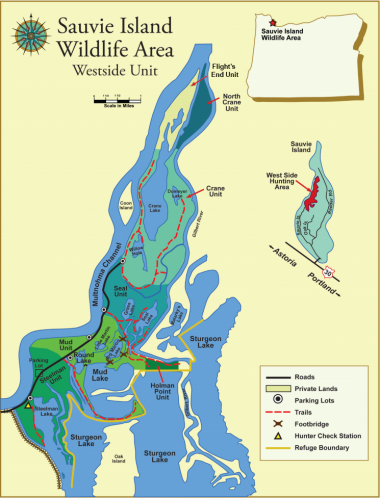
Hunting Sauvie Island’s West Side Unit
A beginner's guide to waterfowl hunting on Sauvie Island- Hunting in the Westside Unit. Part 3 of a 5 part series.

Table of Contents
Part 1: A Beginner's Guide to Waterfowl Hunting on Sauvie Island - An Introduction
Part 2: Hunting Sauvie Island’s East Side Unit
Part 3: Hunting Sauvie Island’s West Side Unit (you are here)
Part 4: Hunting Sauvie Island’s North Side Unit
Part 5: Goose Hunting on Sauvie Island
How to Hunt the Westside Unit
Westside Unit Map (pdf)
Westside Unit Blinds Map (pdf)
Getting There
The Westside is comprised of seven individual hunting units. Access to all Westside subunits is through written SIWA hunting permits issued on hunt days at ODFW’s Westside check station, which is located 9 miles from the Sauvie Island Bridge. To get to the check station from Hwy. 30, cross the Sauvie Island Bridge, stay straight on Sauvie Island Road. Follow Sauvie Island Road for 2 miles and stay left when the road forks. At the fork, continue on Sauvie Island Road an additional 7 miles to where it dead-ends at a gravel parking lot with a gate. The check station is a small, brown trailer just beyond the gate. All seven hunting subunits are accessed from that point. Three of these subunits, Flight’s End, Crane and North Crane, can also be entered by boat via the Multnomah Channel and Gilbert River, but only after first obtaining a SIWA hunting permit at the check station.
Getting a SIWA Westside Hunting Permit
Access to the Westside subunits is by “luck of the draw” at the beginning of each hunting day. Hunters who are in line on the road leading to the check station no later than 90 minutes before shooting time are eligible to participate in a drawing that determines who gets to pick the available hunting subunits first. Each person who is in line on time is given the opportunity to draw a numbered poker chip from a bag full of chips carried by ODFW staff. The person with the lowest number gets first pick of all available hunting positions. The person with the second lowest number gets second pick, and so forth, until all of the hunting positions are assigned. Hunters who do not draw a low enough number to pick one of the available positions have three choices: 1) They can go home and try another day, 2) they can wait around and get in line for a position once it is vacated by the winner, or 3) if they know one of the winners they can hope for an invitation because hunters who draw blinds can take up to three other people along on their hunt.
Once hunters have drawn poker chips they are called to the check station for permits over a low power radio signal that can be heard by tuning in to Channel 1580 on their AM radio dial.
What’s Available on the Westside
The Westside is comprised of seven subunits, four of which contain blinds and hree that are roam subunits.
Westside Blind Subunits
| Holman Point | 6 blinds |
| Mud Lake | 14 blinds |
| Seal | 6 blinds |
| Steelman | 10 blinds |
Westside Roam Subunits
| Crane | 5 parties of up to four hunters each |
| North Crane | 1 party of up to four hunters |
| Flight’s End | 3 parties of up to four hunters each |
The Seal, Steelman and Mud Lake subunits contain “designated shooting sites” marked by posts, while Flight’s End, Crane and North Crane are roam areas. Holman Point is an area containing designated shooting sites. The sites are “slots” where the vegetation has been trimmed to allow pass shooting as birds move between the Sturgeon Lake Refuge and the Eastside Unit. These slots are bordered by the Gilbert River on the north, Sturgeon Lake Refuge on the south and large ash trees on either side. This generally means no water in which to set decoys, except during periods of extremely high water. Hunters must take care to avoid shooting into or setting decoys in the Sturgeon Lake Refuge when hunting Holman Point. While Holman Point is generally not a steady producer, it can be red hot on stormy days when the birds are constantly moving and poor visibility keeps them low.
Header photo by Kathy Munsel



